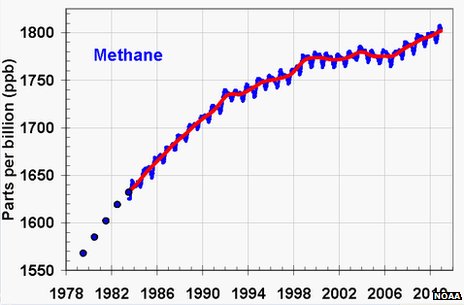In climate change models one of many wild cards is the ancient methane stored in the bottom of shallow icy seas and sequestered away in Arctic permafrost. As the surface temperature warms, the potent greenhouse gas could be released, further warming the region and causing more methane ‘burps’. The process could theoretically feed back and run away, quickly:
(BBC) — We observed most of these cryosphere-cap seeps in lakes along the boundaries of permafrost thaw and in moraines and fjords of retreating glaciers,” they write, emphasising the point that warming in the Arctic is releasing this long-stored carbon.
“If this relationship holds true for other regions where sedimentary basins are at present capped by permafrost, glaciers and ice sheets, such as northern West Siberia, rich in natural gas and partially underlain by thin permafrost predicted to degrade substantially by 2100, a very strong increase in methane carbon cycling will result, with potential implications for climate warming feedbacks.”


About 252 million years ago, the Earth saw the greatest mass extinction in the history of life on this planet: the Permian-Triassic extinction event, aka the Great Dying. It is estimated that 96% of all marine species and 70% of all terrestrial vertibrates were wiped out. It is the only mass extinction event known to have taken insects. All in all, about 57% of all families and 83% of all genera became extinct in a very short period of time.
The extinction had two phases. The first seems to be related to a gradual warming of the planet, resulting in a relatively slow decline of species. The second happened all at once, geologically speaking; this second phase accounts for the vast majority of the extinctions.
And what caused it? The leading theory is that the warming seas caused clathrates at the bottom of the seas to melt, releasing massive amounts of methane which poisoned the sea life and eventually became greenhouse gas that accelerated global warming, which melted more clathrates, which released more methane, and so on.
It is beginning again.
Is the P-T clathrate gun hypothesis still solid?
@ ^ Stephen “DarkSyde” Andrew : From reading Hansen’s Storms of my grandchildren book yeah, this scares me. :(
Haven’t heard anything to contradict or provide reason to doubt the PETM methane clathrate “gun” since.
See this :
http://www.youtube.com/watch?v=krBeW5LWs3M&feature=related
to add some perspective too.
Yes, it’s happening. Not good.
@Stephen #2 – From what I’ve been reading, it still seems a pretty solid theory. There is debate about what caused the P-T extinction, of course, but the only people who say that the clathrate gun hypothesis is unlikely appear also to be globa warming denialists.
RealClimate.org has addressed this concern twice that I can find.
In both cases, they seem to see it as a secondary concern, compared with carbon dioxide. I can’t quite follow the arguments given, but maybe that’s because my viewpoint on this issue has been permanently bent by reading John Barnes’s sf disaster/satire Mother of Storms.
There’s a recent lecture on Youtube here :
http://www.youtube.com/watch?v=lsttlecbRWI
From March this year by an expert.
Also keep track of the rising carbon dioxide here :
http://co2now.org/
among other places.
Is it just me or has the rise been accelerating lately?
There is growing concern that Methane release will spell the end of all life on Earth”
http://www.methaneburp.com